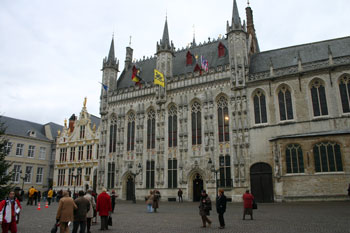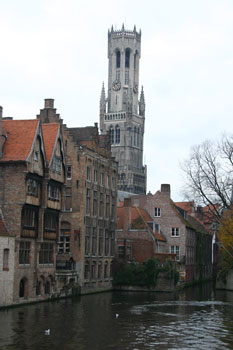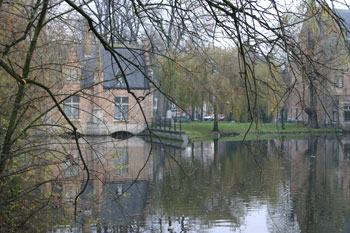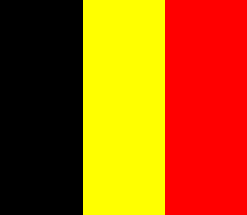Saturday 27 November 2004
We
take the 9.24 International train from Rotterdam Centraal to Antwerpen Centraal.
There we change trains. The connecting Intercity in the direction of Ostend is
waiting for us across the platform. We arrive in Bruges around noon. A taxi
takes us to the Ibis
hotel in the centre of Bruges in about 5 minutes. We have lunch on the Simon
Stevin square, this time of year the scene for a lively Christmas market. After
lunch we continue towards the Market Square (Markt), where want to take part in
a guided bike tour organised by Pink Bear. According to our (internet) information this
is the only organisation running bike tours all year. But at 1.30pm there is no
guide at the foot of the Belfry tower. We make a phone call only to find out
that tours are only carried out in the morning hours during the winter months. We
then start our self guided walk through the beautiful old town. We start on the
Markt with the 13th century Lakenhal, once the scene of the cloth trade.
Opposite there are numerous quintessential gabled houses. The facades look old
but most of them are 19th century re-creations or re-inventions, when Bruges was
finally "discovered" for (British) tourism in the middle of the 19th
century. A gothic revival took place in which
bike tour organised by Pink Bear. According to our (internet) information this
is the only organisation running bike tours all year. But at 1.30pm there is no
guide at the foot of the Belfry tower. We make a phone call only to find out
that tours are only carried out in the morning hours during the winter months. We
then start our self guided walk through the beautiful old town. We start on the
Markt with the 13th century Lakenhal, once the scene of the cloth trade.
Opposite there are numerous quintessential gabled houses. The facades look old
but most of them are 19th century re-creations or re-inventions, when Bruges was
finally "discovered" for (British) tourism in the middle of the 19th
century. A gothic revival took place in which  lots
of places that did not look medieval enough were reshaped. The Belfry
tower (13th century) is the biggest eye catcher and was built in an age that
Bruges was politically and economically at the top of its might. The tower
can be climbed and offers great views. We continue towards the Burg, another
fine square with buildings like the Gothic town hall, the law courts (now city
archive) ,Het Brugse Vrije (Mansion of Bruges Liberties; now Tourist
Office) and the Heilig Bloed Basiliek (Basilica of the Holy Blood).
We pay a visit to the Basilica. This is where one of Flanders most venerated
relics is kept: The Holy Blood, which is carried around the city during the Ascension
Day procession. Inside the upper chapel an announcement in 7 languages
lets us know that we are allowed to touch the silver tabernacle (under
supervision) whilst making a personal prayer. We go on through the Blinde
Ezelsteeg (Blind Donkey Alley) and the Huidevetterplein (Tanner
Square) towards the Rozenhoedkaai. Here tourist herd together in droves to shoot
the postcard perfect view of the Belfry tower. On we go to the Groeninge
museum. This museum hosts a fine collection of mostly renaissance en
gothic paintings, among which quite a number of early Flemish paintings. We walk
on through the garden and a number of gates leading through the Arentspark to
one of the smallest bridges of the city, the Bonifaciusbrug. It is one of
Bruges' most picturesque and photographed bridges and looks very medieval. It
was built, however, in 1910! This leads us to the Gruuthusemuseum.
The Gruuthuse is a city palace, once the home to the noblemen who had the
privilege to levy taxes on traded gruits, once an ingredient for beer. The
house is now home to a collection of applied art from the 13th through 19th
centuries. From here we visit the Onze
Lieve Vrouwe kerk (Church of our Lady) Pride of the
church is a marble Madonna with child by lots
of places that did not look medieval enough were reshaped. The Belfry
tower (13th century) is the biggest eye catcher and was built in an age that
Bruges was politically and economically at the top of its might. The tower
can be climbed and offers great views. We continue towards the Burg, another
fine square with buildings like the Gothic town hall, the law courts (now city
archive) ,Het Brugse Vrije (Mansion of Bruges Liberties; now Tourist
Office) and the Heilig Bloed Basiliek (Basilica of the Holy Blood).
We pay a visit to the Basilica. This is where one of Flanders most venerated
relics is kept: The Holy Blood, which is carried around the city during the Ascension
Day procession. Inside the upper chapel an announcement in 7 languages
lets us know that we are allowed to touch the silver tabernacle (under
supervision) whilst making a personal prayer. We go on through the Blinde
Ezelsteeg (Blind Donkey Alley) and the Huidevetterplein (Tanner
Square) towards the Rozenhoedkaai. Here tourist herd together in droves to shoot
the postcard perfect view of the Belfry tower. On we go to the Groeninge
museum. This museum hosts a fine collection of mostly renaissance en
gothic paintings, among which quite a number of early Flemish paintings. We walk
on through the garden and a number of gates leading through the Arentspark to
one of the smallest bridges of the city, the Bonifaciusbrug. It is one of
Bruges' most picturesque and photographed bridges and looks very medieval. It
was built, however, in 1910! This leads us to the Gruuthusemuseum.
The Gruuthuse is a city palace, once the home to the noblemen who had the
privilege to levy taxes on traded gruits, once an ingredient for beer. The
house is now home to a collection of applied art from the 13th through 19th
centuries. From here we visit the Onze
Lieve Vrouwe kerk (Church of our Lady) Pride of the
church is a marble Madonna with child by Michelangelo. It is the only work of the Italian artist to have left Italy
during his lifetime. The church is also famous for the graves of the Burgundy
duke Charles the Bold and his daughter Maria of Burgundy. Next on our tour is
the Salvatorkerk with paintings by Jan van Orley. These paintings from 1730
served as models for tapestries which are also on display in the church.
Unfortunately mass is starting when we enter the church and we are unable to see
most of the paintings and tapestries.
Michelangelo. It is the only work of the Italian artist to have left Italy
during his lifetime. The church is also famous for the graves of the Burgundy
duke Charles the Bold and his daughter Maria of Burgundy. Next on our tour is
the Salvatorkerk with paintings by Jan van Orley. These paintings from 1730
served as models for tapestries which are also on display in the church.
Unfortunately mass is starting when we enter the church and we are unable to see
most of the paintings and tapestries.
We
come past the 800 year old St Janshospitaal, now home to the Memlingmuseum. In
the Walstraat (Wall Street) we buy chocolate and marzipan, Belgian
goodies which are for sale in almost every other shop. Bruges is firmly on the -
predominantly English - tourist trail and most shops sell Belgian lace,
chocolate, beer or antiques and we are more often than not welcomed in English.
It sometimes takes some effort (and persistence) to get some service in Dutch.
Just before sunset we pay a visit to the Halve Maan Brewery, where
the Bruges beer Straffe Hendrik is being brewed. We take part in the
amusing tour of the place, which takes us not only to brewing kettles and the
like, but also the roof of the brewery, which offers great views of the city and
the nearby Begijnhof (Béguinages, a community of religious widowed or unmarried
women) and the Minnewater lake. At the end of the tour a nice glass of
Straffe Hendrik awaits us in the brewery's café (included in the ticket).
Halve Maan Brewery, where
the Bruges beer Straffe Hendrik is being brewed. We take part in the
amusing tour of the place, which takes us not only to brewing kettles and the
like, but also the roof of the brewery, which offers great views of the city and
the nearby Begijnhof (Béguinages, a community of religious widowed or unmarried
women) and the Minnewater lake. At the end of the tour a nice glass of
Straffe Hendrik awaits us in the brewery's café (included in the ticket).
At
night we have dinner at Cafedraal, a trendy
restaurant with Flemish and Mediterranean dishes. Lovely food, good service and
a fair choice of wines. After dinner we head for Bolero, the only little gay bar
in town. When we get there around 9.30 it is (unsurprisingly) frighteningly
quiet. After an hour or so more people come in, but we have become tired
and call it a day.
Weather:
grey day, cold, but dry.
|

 bike tour organised by Pink Bear. According to our (internet) information this
is the only organisation running bike tours all year. But at 1.30pm there is no
guide at the foot of the Belfry tower. We make a phone call only to find out
that tours are only carried out in the morning hours during the winter months. We
then start our self guided walk through the beautiful old town. We start on the
Markt with the 13th century Lakenhal, once the scene of the cloth trade.
Opposite there are numerous quintessential gabled houses. The facades look old
but most of them are 19th century re-creations or re-inventions, when Bruges was
finally "discovered" for (British) tourism in the middle of the 19th
century. A gothic revival took place in which
bike tour organised by Pink Bear. According to our (internet) information this
is the only organisation running bike tours all year. But at 1.30pm there is no
guide at the foot of the Belfry tower. We make a phone call only to find out
that tours are only carried out in the morning hours during the winter months. We
then start our self guided walk through the beautiful old town. We start on the
Markt with the 13th century Lakenhal, once the scene of the cloth trade.
Opposite there are numerous quintessential gabled houses. The facades look old
but most of them are 19th century re-creations or re-inventions, when Bruges was
finally "discovered" for (British) tourism in the middle of the 19th
century. A gothic revival took place in which  lots
of places that did not look medieval enough were reshaped. The Belfry
tower (13th century) is the biggest eye catcher and was built in an age that
Bruges was politically and economically at the top of its might. The tower
can be climbed and offers great views. We continue towards the Burg, another
fine square with buildings like the Gothic town hall, the law courts (now city
archive) ,Het Brugse Vrije (Mansion of Bruges Liberties; now Tourist
Office) and the Heilig Bloed Basiliek (Basilica of the Holy Blood).
We pay a visit to the Basilica. This is where one of Flanders most venerated
relics is kept: The Holy Blood, which is carried around the city during the Ascension
Day procession. Inside the upper chapel an announcement in 7 languages
lets us know that we are allowed to touch the silver tabernacle (under
supervision) whilst making a personal prayer. We go on through the Blinde
Ezelsteeg (Blind Donkey Alley) and the Huidevetterplein (Tanner
Square) towards the Rozenhoedkaai. Here tourist herd together in droves to shoot
the postcard perfect view of the Belfry tower. On we go to the
lots
of places that did not look medieval enough were reshaped. The Belfry
tower (13th century) is the biggest eye catcher and was built in an age that
Bruges was politically and economically at the top of its might. The tower
can be climbed and offers great views. We continue towards the Burg, another
fine square with buildings like the Gothic town hall, the law courts (now city
archive) ,Het Brugse Vrije (Mansion of Bruges Liberties; now Tourist
Office) and the Heilig Bloed Basiliek (Basilica of the Holy Blood).
We pay a visit to the Basilica. This is where one of Flanders most venerated
relics is kept: The Holy Blood, which is carried around the city during the Ascension
Day procession. Inside the upper chapel an announcement in 7 languages
lets us know that we are allowed to touch the silver tabernacle (under
supervision) whilst making a personal prayer. We go on through the Blinde
Ezelsteeg (Blind Donkey Alley) and the Huidevetterplein (Tanner
Square) towards the Rozenhoedkaai. Here tourist herd together in droves to shoot
the postcard perfect view of the Belfry tower. On we go to the  Michelangelo. It is the only work of the Italian artist to have left Italy
during his lifetime. The church is also famous for the graves of the Burgundy
duke Charles the Bold and his daughter Maria of Burgundy. Next on our tour is
the Salvatorkerk with paintings by Jan van Orley. These paintings from 1730
served as models for tapestries which are also on display in the church.
Unfortunately mass is starting when we enter the church and we are unable to see
most of the paintings and tapestries.
Michelangelo. It is the only work of the Italian artist to have left Italy
during his lifetime. The church is also famous for the graves of the Burgundy
duke Charles the Bold and his daughter Maria of Burgundy. Next on our tour is
the Salvatorkerk with paintings by Jan van Orley. These paintings from 1730
served as models for tapestries which are also on display in the church.
Unfortunately mass is starting when we enter the church and we are unable to see
most of the paintings and tapestries. 